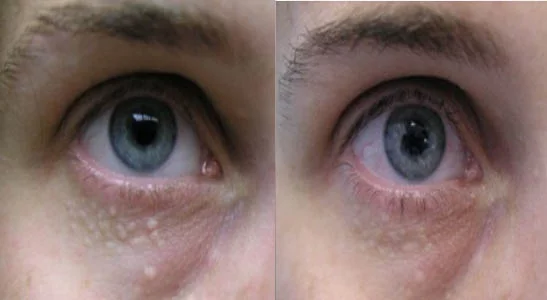A Syringoma is a completely harmless, non-cancerous, growth caused by overactive sweat glands (eccrine glands). They are skin-colored or yellowish firm, rounded bumps, measuring 1–3 mm in diameter.
They most often appear in clusters on the eyelids, but they may also appear on other parts of the face and occasionally over the armpits, umbilicus, upper chest, and vulva. They are more common in women, particularly in middle-aged women. While they can appear at any age, they are most common during adolescence. They are usually not associated with other symptoms, but they can occasionally cause itchiness or irritation.
This form is most commonly seen on the anterior chest, abdomen, neck, and arms. It appears in several crops, with periods of relaxation in between active rash periods.
Milia-like syringoma is characterised by smaller lesions with a milky white centre that resembles milia.
This type is more commonly associated with itchiness and chronic scratching that leads to epidermal thickening similar to lichen planus.
In certain cases of syringoma, there is a hereditary pattern of inheritance in an autosomal dominant pattern. The genetic link between syringoma and chromosome 16q22 has been discovered.
Syringomas are usually not dangerous and normally in most cases no treatment is necessary. However, they may be treated if they cause emotional distress especially when extensive or disfiguring. Some syringomas develop close to delicate tissues, such as the eyes or the genitals. Syringomas in these sensitive areas can cause inflammation and injury, so they should be removed.
Medication for syringomas include oral medication like isotretinoin and ointments and creams which contain trichloroacetic acid, applied to syringomas makes them shrivel and fall off after a few days. These techniques, however, aren’t thought to be as successful as interventional dermatological procedures mentioned below.
Syringomas can be treated using a variety of surgical techniques. Standard cutting, scraping, and peeling tools are used to surgically extract syringoma. Excision almost always results in scarring and tissue damage, so surgery is always the last resort.
Cryotherapy involves freezing the lesions with liquid nitrogen; usually multiple sessions are required and usually not preferable procedure for removal of Syringoma.
Dermabrasion involves entails rubbing off the top layer of your skin, including the tumours, with abrasive substances. Syringomas that are deeply embedded in skin are unsuitable for this treatment.
Certain chemicals, most notably trichloroacetic acid, may be directly applied to the syringoma, causing it to dry up and fall off. Glycolic acid, pyruvic acid, mandelic acid, lactic acid, and salicylic acid are some of the chemicals to search for and factors to consider a clean, efficient exfoliator. Chemical peeling done by trained professional will carry less risk and scarring.
Syringoma removal by laser treatments are preferred by many dermatologists, as it has the lowest risk of scarring. However in most of the cases, a single laser session is required to completely remove the growth.
The most widely used laser devices are ablative CO2 and erbium yag lasers. It takes time for the body to heal varying from 5 to 14 days depending upon the size of lesion. Temporary hyper- or hypo-pigmentation can occur in darker skin types and can resolve in several months.
Electrosurgeries and laser surgeries are preferred by surgeons over other treatments because they leave no visible scar. Electrosurgery, like laser surgery, usually only requires one session to fully remove the syringoma. Electrical currents are localised and sent through the syringoma during electrosurgery. These currents disrupt blood vessels and unwanted tissues.
| DO | DON'T |
|---|---|
| Use regular sunscreen (> SPF 30) | Do not get overexpose to sunlight |
| Avoid irritants and allergens on the skin | Do not go outdoors without sunscreen |
| Ensuring that blood sugar levels are within a safe range; as syringomas are one of complication of diabetes | Donot forget to Consume a nutritious, well-balanced diet rich in skin nutrients like vitamin A and E may help. |
| Use a home exfoliating remedies or over-the-counter items, once a week or as required may help in further development of the lesions. | Do not forget to use physical sun protection like umbrella, broad-brimmed hats on outdoors |

